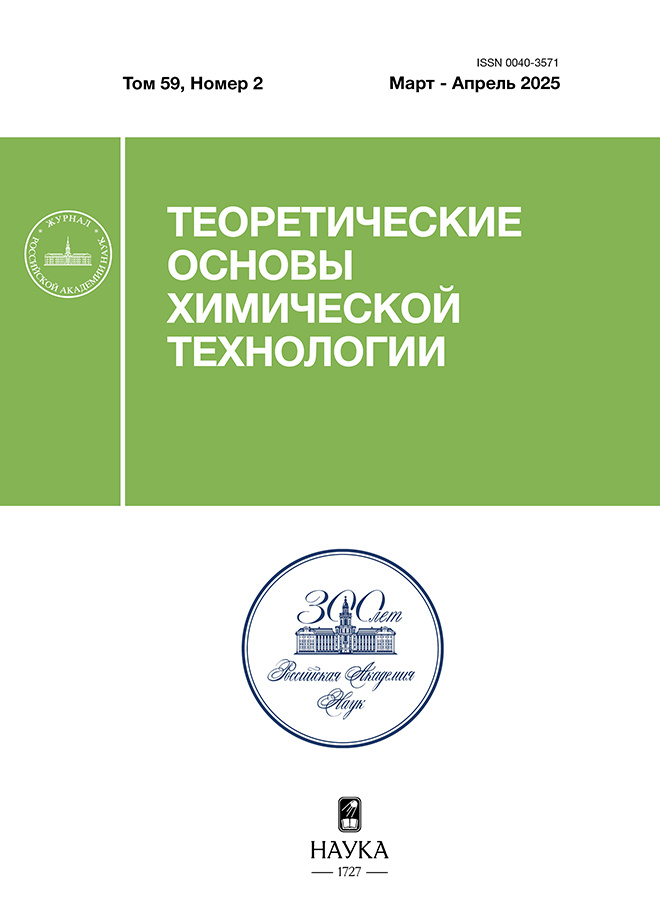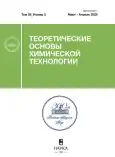Теоретические основы химической технологии
Свидетельство о регистрации СМИ: ПИ № ФС 77 - 83659 от 05.08.2022
Рецензируемый академический научный журнал издается с 1967 года.
Главный редактор
- доктор технических наук, член-корреспондент РАН, профессор Вошкин Андрей Алексеевич
Заместитель главного редактора
- доктор технических наук, академик РАН, профессор Мешалкин Валерий Павлович
Учредители
- Российская академия наук
- Институт общей и неорганической химии им. Н.С. Курнакова РАН
Издатель
- Российская академия наук
О журнале
В журнале публикуются работы по всем разделам химической технологии, включая явления переноса, поверхностные явления, процессы разделения смесей, теорию и методы расчета химических реакторов, био- и нанотехнологию, дисперсные системы, методы интенсификации, моделирование и управление химико-технологическими процессами и системами, проблемы надежности и безопасности химических производств, вопросы энерго- и ресурсосбережения, экологию и т. д.
Журнал является рецензируемым, включен в Перечень ВАК. Входит в систему РИНЦ и международные базы данных Web of Sciencе и Scopus.
Текущий выпуск
Том 59, № 2 (2025)
- Год: 2025
- Выпуск опубликован: 15.04.2025
- Статей: 11
- URL: https://gynecology.orscience.ru/0040-3571/issue/view/13849
Статьи
Экстракция металлов из нитратных растворов глубоким эвтектическим растворителем ди(2,4,4-триметилпентил)фосфиновая кислота/фенол
Аннотация
Установлен качественный и количественный состав магнита NdFeB, изучены особенности выщелачивания металлов раствором азотной кислоты. Подобраны оптимальные условия процесса наиболее полного выщелачивания металлов. Для выделения ряда металлов из азотнокислого раствора выщелачивания неодимовых магнитов был предложен в качестве экстрагента гидрофобный глубокий эвтектический растворитель на основе ди(2,4,4-триметилпентил)фосфиновой кислоты (ДТМПФК) и фенола. Получены экспериментальные данные по экстракции ионов Ni, Fe, Al и Cu из модельных индивидуальных и смешанных растворов глубоким эвтектическим растворителем ДТМПФК/фенол при варьировании ключевых условий проведения процесса: кислотности среды, концентрации высаливателя, соотношения компонентов в эвтектическом растворителе, концентрации металла и др. Полученные результаты указывают на перспективность применения глубокого эвтектического растворителя ДТМПФК/фенол для извлечения катионов Ni, Fe, Al и Cu в процессах переработки отходов магнитных материалов.
 3-13
3-13


Исследование взаимосвязи состава водных смесей, содержащих сложные эфиры и спирты, с энергоэффективностью схем разделения
Аннотация
В статье на примере водных систем, содержащих гомологи спиртов и алкилацетатов, показана возможность прогнозирования энергозатрат технологических схем разделения смесей разного состава. Предложены изомерные структуры схем выделения продуктов, базирующиеся на применении обычной и (авто)экстрактивной ректификации. Определены статические параметры работы колонн, обеспечивающие требуемое качество продуктовых потоков. Выявлены зависимости изменения суммарных энергозатрат схем от молекулярной массы компонентов-гомологов и состава исходных смесей.
 14-32
14-32


Сравнение температурной и ультразвуковой интенсификации сверхкритической флюидной экстракции на примере семян пастернака посевного
Аннотация
Проведено сравнение температурной и ультразвуковой интенсификации сверхкритической флюидной экстракции на примере семян пастернака посевного, источника растительного масла и фурокумариновых фотосенсибилизаторов. Обнаружено, что даже при давлении 300 бар влияние температуры на процесс экстракции пастернака имеет так называемый ретроградный характер, то есть изобарическое повышение температуры ведет к уменьшению общего массового выхода экстракции и скорости извлечения. Выдвинутая ранее гипотеза о хроматографоподобном протекании процесса сверхкритической экстракции позволяет объяснить закономерности ретроградного поведения, нехарактерного для столь высоких давлений экстракции. Показано, что общий паттерн ультразвуковой интенсификации экстракции подобен температурной. При малом давлении экстракции (100 бар) в условиях принципиальной возможности кавитации поступающего в экстракционную зону субкритического флюида, ультразвуковая обработка приводит к росту скорости извлечения экстрактивных веществ на начальном, линейном этапе экстракции. При высоком рабочем давлении экстракции (300 бар) эффект ультразвуковой обработки фактически тождественен эффекту температурной интенсификации. Методом сверхкритической флюидной хроматографии показано, что фурокумариновые профили экстрактов пастернака, полученных с температурной и ультразвуковой интенсификацией, идентичны на качественном уровне, и что ультразвуковая обработка даже при давлении 100 бар не приводит к нежелательным сонохимическим эффектам.
 33-46
33-46


Использование клеточно-автоматного подхода для создания цифровых двойников иерархических пористых структур
Аннотация
В статье предложена мультимасштабная модель на основе клеточно-автоматного подхода для создания цифровых двойников пористых иерархических структур аэрогелей на основе альгината натрия. Предлагаемая модель использует клеточно-автоматный подход для генерации структур на мезо- и макроуровнях с их последующим объединением в единую цифровую мультимасштабную структуру, которая содержит как мезо-, так и макропоры. Экспериментально исследованы образцы аэрогелей на основе альгината натрия. Проведены вычислительные эксперименты по генерации цифровых структур, соответствующих полученным экспериментальным образцам. Дано сравнение структурных характеристик цифровых и экспериментальных образцов, на основе которых были сделаны выводы о корректной работе модели. Полученные цифровые мультимасштабные структуры могут быть использованы в дальнейшем для прогнозирования свойств иерархических структур, что позволит частично заменить натурные эксперименты вычислительными и, следовательно, снизить затраты при разработке новых материалов с заданными свойствами.
 47-57
47-57


Сорбционное разделение смеси катионов ниобий–цирконий
Аннотация
В работе впервые показана возможность использования сорбционных технологий для разделения смеси радиоактивных катионов ниобия и циркония, входящих в состав отходов, образующихся в ядерном топливном цикле. Разделение этих элементов позволит значительно снизить затраты на захоронение отходов, а также даст возможность повторного использования ионов циркония. В работе детально исследован процесс разделения ионов с использованием анионообменника АВ-17-8, подобраны условия для более эффективного проведения процесса в динамических условиях и предложен его механизм.
 58-64
58-64


Влияние продольной диффузии на технологические параметры барабанной сушилки
Аннотация
На основании дифференциальных уравнений материального баланса и массопередачи для высушиваемого материала и сушильного агента выведены уравнения рабочей и равновесной линии при противоточном движении фаз в барабанной сушилке. Предложен алгоритм расчета и проведено сравнение технологических параметров процесса сушки с учетом продольной диффузии с аналогичными параметрами, рассчитанными по типовому алгоритму. Приведены графики полученных результатов в косоугольной диаграмме Рамзина и прямоугольных координатах Эйлера. Показано, что с учетом числа Пекле продольной диффузии, то есть перехода от режима вытеснения к режиму продольного смешения, рассчитанные длину и объем барабана необходимо увеличивать в 1.1 и более раз при Pe < 30.
 65-78
65-78


Структура потока при всплытии одиночного пузырька в жидкости с растворенным поверхностно-активным веществом
Аннотация
Представлены результаты математического моделирования нестационарной задачи всплытия газового пузырька в вязкой жидкости с растворенным в ней поверхностно-активным веществом (ПАВ). Постановка задачи записана с учетом эффектов адсорбции и десорбции ПАВ на межфазной границе и зависимости коэффициента поверхностного натяжения от концентрации по закону Ленгмюра. Численный алгоритм решения основан на оригинальной методике Лагранжа-Эйлера, позволяющей явно выделять свободную поверхность на дискретном уровне и реализовывать естественные граничные условия на ней. Изучен процесс установления стационарной скорости всплытия пузырька и выполнены параметрические исследования влияния объемной концентрации ПАВ и размера пузырька на стационарную скорость и структуру течения в его окрестности. Представлены распределения компонент вектора скорости и поверхностной концентрации вдоль межфазной границы, демонстрирующие влияние эффекта Марангони на процесс всплытия.
 79-89
79-89


Концентрационное распределение молекул и частиц в хромсодержащей модельной системе: Fe-K2Cr2O7-NaCl-H2SO4-H2O при различных температурах процесса электрокоагуляции
Аннотация
С целью очистки воды от хрома (Cr6+) осуществлено термодинамическое моделирование процесса электрокоагуляции в системе Fe–K2Cr2O7–NaCl–H2SO4–H2O при широких пределах изменения температуры (278–300 К). Рассчитаны физико-химические (pH, I, Eh, Cp) и термодинамические (H, S, U, G) параметры системы при установленных оптимальных соотношениях исходных компонентов. С учетом расчетных данных проведено экспериментальное исследование и выявлено влияние на процессы электрокоагуляции: рН, силы тока, вида и концентрации электролитов. Установлено концентрационное распределение отдельных молекул и частиц (катионы, анионы), в том числе: Cr2+, Cr3+, CrO+, CrOH2+, Fe+, FeOH+, FeOH2+ в растворе, и тем самым исключено применение ионной хроматографии в аналитических целях. Составлена диаграмма Eh-pH с указанием полей присутствия различных форм хрома, и получена формула для расчета величины окислительного-восстановительного потенциала в зависимости от рН раствора. Показано, что Eh > 0, т. е. среда окислительная, и отмечено образование Cr3+ в концентрированном растворе (I > 0.8). В процессе электрокоагуляции достигнуто связывание серы и железа в виде FeS2 и с последующим получением Fe(ОН)3 и соосаждением Cr(OH)3. Степень очистки воды от хрома составила более 97% (уменьшение Cr6+ в воде от 100 мг/л до 2.29–2.30 мг/л).
 90-99
90-99


Математическое моделирование процесса бинарной коалесценции капель водонефтяной эмульсии
Аннотация
В работе представлена попытка формирования общего подхода к математическому моделированию бинарной коалесценции, возникающей за счет осаждения капель в гравитационном поле, основанному на уравнении популяционного баланса, который в дальнейшем может быть применен для прогнозирования условий расслоения водонефтяных эмульсий. С использованием экспериментальных кривых изменения содержания воды во времени в водонефтяных эмульсиях, измеренных при разных температурах, произведено сравнение четырех разных способов расчета эффективности бинарной коалесценции.
 100-110
100-110


Экспериментальное исследование кинетики реакции соляной кислоты с карбонатными породами при термобарических условиях пласта
Аннотация
Взаимодействие кислоты с карбонатными породами является основой процессов повышения продуктивности добывающих скважин и интенсификации добычи нефти из карбонатных коллекторов. Растворение карбонатов в условиях фильтрации раствора кислоты через пористую среду определяется конкуренцией процессов химической реакции и конвективного переноса кислоты. Исследование этих конкурирующих процессов проводится на двух основных установках: вращающемся карбонатном диске, омываемом потоком кислоты, и установке по фильтрации раствора кислоты через образцы карбонатного коллектора. В работе представлены результаты таких исследований с обсуждением и определением параметров кинетики реакции на образце конкретного месторождения. Рассчитаны значения диффузии и кинетики реакции, критической скорости образования червоточин в пористой среде при различных концентрациях соляной кислоты. Оценены значения основных безразмерных комплексов подобия: чисел Дамкелера, Пекле и растворяющей способности кислоты.
 111-120
111-120


Метод построения моделей для оценки показателей качества продуктов колонны фракционирования в условиях малого объема данных аналитического контроля
Аннотация
Рассматривается задача повышения точности моделей для оценки показателей низкотемпературных свойств, показателей воспламеняемости и противоизносных свойств целевых продуктов колонны фракционирования в условиях малого объема данных аналитического контроля. Для решения рассматриваемой задачи предложен метод построения моделей, в составе которого используется алгоритм расширения малой обучающей выборки по данным фракционного состава, отличающийся способом отбора дополнительных данных, учитывающим показатель разреженности, что позволило включить в обучающую выборку недостающее количество данных, и в итоге обеспечить повышение качества модели. Использование предложенного метода позволило повысить точность моделей в среднем на 18% в сравнении с известными методами и в среднем на 6% в сравнении с методом на основе расширения обучающей выборки без учета показателя разреженности. Результаты представлены на примерах построения моделей показателей качества предельной температуры фильтруемости, температуры вспышки, кинематической вязкости при 40ºC и цетанового числа среднего дистиллята (фракции дизельного топлива) и температуры вспышки керосиновой фракции промышленной колонны фракционирования технологической установки гидрокрекинга.
 121-137
121-137










